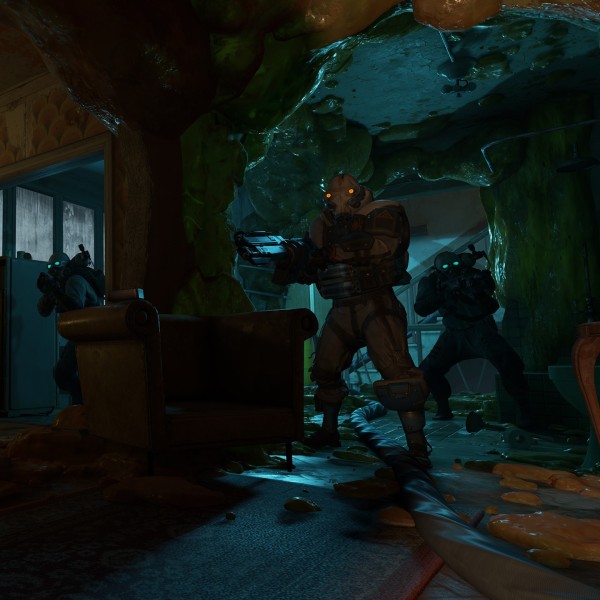The Vulkan® Working Group has released the VK_KHR_pipeline_binary extension, enabling direct retrieval of binary data associated with individual pipelines, bypassing the VkPipelineCache mechanism, and enabling applications to explicitly manage pipeline caching.
Learn
'->'人工智能与机器学习,Python的TensorFlow和Scikit-learn #生活技巧# #工作学习技巧# #编程学习路径#
The essential resources for Vulkan development
Key Resources
Thanks to the support of the Khronos membership and our passionate developer community, there is a full set of well-supported developer information and educational resources to help quickly get you up and running with your Vulkan application development.

SUPERHOT: MIND CONTROL DELETE - SuperHot
The essential resources for Vulkan development
Key Resources
Thanks to the support of the Khronos membership and our passionate developer community, there is a full set of well-supported developer information and educational resources to help quickly get you up and running with your Vulkan application development.
The docs.vulkan.org website brings together key documents such as the Vulkan specification, Vulkan Guide, tutorials and Vulkan samples providing a consistent navigation and search interface across all of these.
Find Out More
Khronos provides a collection of Vulkan Samples and resources that run in a unified environment to maximise ease of use and testing of certain Vulkan features or extensions.
Many of the samples run across all platforms with some showcasing features that are platform specific.
Find Out More
The Vulkan Guide is designed to help developers get up and going with the world of Vulkan. It is aimed to be a light read that leads to many other useful links depending on what a developer is looking for.
All information is intended to help better fill the gaps about the many nuances of Vulkan.
We encourage developers to see this as a map of the API that provide a clear breakdown of the structure and interconnectivity of Vulkan.
Find Out More
This tutorial will teach you the basics of using the Vulkan graphics and compute API. The Khronos Vulkan® Tutorial is based on the "Vulkan Tutorial" by Alexander Overvoorde licensed under CC BY-SA 4.0.
Find Out More
The most popular tutorials for getting started
Vulkan Tutorials
Vulkan is by design a low-level API that removes many of the abstractions found in previous generation graphics APIs. This is great for delivering maximum performance, but has the side effect of exposing more complexity to the developer. Fortunately, several excellent tutorials exist to help clear this hurdle and get productive quickly.

NAP Framework - Naivi.nl
The most popular tutorials for getting started
Vulkan Tutorials
Vulkan is by design a low-level API that removes many of the abstractions found in previous generation graphics APIs. This is great for delivering maximum performance, but has the side effect of exposing more complexity to the developer. Fortunately, several excellent tutorials exist to help clear this hurdle and get productive quickly.
New to Vulkan? This Vulkan tutorial will teach you the basics of using the Vulkan graphics and compute API.
The ideas behind Vulkan are similar to those of Direct3D 12 and Metal, but Vulkan has the advantage of being fully cross-platform and allows you to develop for Windows, Linux and Android at the same time.
Come take the tour to start familiarizing yourself with this powerful graphics API can deliver outstanding performance no matter what you are developing for.
The Khronos Vulkan® Tutorial is based on the "Vulkan Tutorial" by Alexander Overvoorde licensed under CC BY-SA 4.0.
Learn More
Sascha has developed a comprehensive collection of open source C++ examples for Vulkan, the new generation graphics and compute API from Khronos.
These are a great way to get familiar with the basics of Vulkan from drawing your first triangle to learning many of the key constructs of the API (pipelines, descriptor sets, render passes, and much more).
These samples are an even more effective resource when used alongside the Vulkan Samples.
Learn More
Master Vulkan 1.3 with practical recipes for building, rendering, and optimizing stunning 3D graphics, guided by AR and rendering experts Sergey Kosarevsky and Alexey Medvedev.
Learn More
OGLDEV is a YouTube channel focused on 3D rendering, with in-depth tutorials using OpenGL and Vulkan. The Vulkan playlist guides viewers from foundational concepts like instance and surface creation all the way to advanced topics such as dynamic rendering, cubemaps, asset loading with Assimp, and ImGUI integration. All sample code is cross-platform and can be built on both Windows and Linux, making it a versatile resource for developers at any level.
Find Out More
For some good perspective on how to think about Vulkan and the steps needed to get proficient, check out this blog by Jeremy Young.
Learn More
For those who have a good grounding in existing APIs (e.g. D3D11 and GL) and understand the concepts of multithreading, staging resources and synchronisation but want to know how to implement these with Vulkan.
The RenderDoc team provides us with a whirlwind tour of what the main Vulkan concepts look like.
Learn More
Vulkan’s barrier system is unique as it not only requires you to provide what resources are transitioning, but also specify a source and destination pipeline stage.
This allows for more fine-grained control of when a transition is executed. However, you can also leave quite a lot of performance on the table if you just use the simple method. This tutorial will cover how to handle this properly.
Learn More
AMD sponsored GPUOpen provides a set of resources to help you learn about Vulkan's low-level graphics APIs for creating games and other graphics applications.
It also includes a number of developer case studies on developing with and porting to Vulkan.
Learn More
The goal of this guide is to understand Vulkan correctly, and act as a stepping stone for then working in your own projects.
With a focus around dynamic rendering, this guide is intended to act as a strong base code for a game engine
Learn More
Arseny Kapoulkine covers a wide range of topics in this break down of Vulkan performance. Originally part of the GPU Zen 2 book this section is now available for free and a must read for developers looking to squeeze the most out of Vulkan.
Learn More
Brendan Galea has created a nice set of video tutorials that walk developers through a number of Vulkan technical topics including introdcutory topics like opening a window to more advanced topics like Fragment Interpolation, Pipeline Setup, Swap Chains, Push Constants, etc.
Find Out More
A Vulkan Lecture Series from Johannes Unterguggenberger explaining some of the basics for Vulkan developers getting started with Vulkan.
Find out more
Guides to best practice Vulkan development
Vulkan Best Practice
Here you'll find guidelines and tips for how to get the best performance from your target platform direct from the hardware manufacturer.

Half-Life: Alyx - Valve
Guides to best practice Vulkan development
Vulkan Best Practice
Here you'll find guidelines and tips for how to get the best performance from your target platform direct from the hardware manufacturer.
Our AMD RDNA™ Performance Guide, with updates for RDNA 3, will help guide you through the optimization process with a collection of tidbits, tips, and tricks which aim to support you in your performance quest.
AMD RDNA™ Performance Guide
Vulkan API Best Practices on AndroidHow to Get the Most Out of the Vulkan API on Android
Understanding Render Passes Vulkan Samples: Bandwidth and Throughput Optimizations for Mobile Vulkan Samples: Render Passes and Wait Idle Examples Vulkan Samples Release Summary BlogBlog which Includes links to info on several ARM contributions to Vulkan best practices.
PowerVR Performance RecommendationsIn depth article which serves as recommendation and advice for developers who wish to get the best graphics performance from a PowerVR SGX or PowerVR Rogue enabled device.
Vulkan synchronisation and graphics-compute-graphics hazards - Part 1Part 1 of a 2-part blog series exploring the complexities of multi-threaded synchronization in Vulkan and some of the tools available on PowerVR platforms to help tune for best performance.
Vulkan synchronisation and graphics-compute-graphics hazards - Part 2Part 2 of a 2-part blog series exploring the complexities of multi-threaded synchronization in Vulkan and some of the tools available on PowerVR platforms to help tune for best performance.
Intel's tools, libraries, and plug-insIntel's tools, libraries, and plug-ins help you build, profile, analyze, and optimize your games. Achieve maximum performance and productivity, improve visuals, and provide the best gaming experiences on Intel® hardware
Graphics API Performance Guide for Intel® Processor Graphics Gen9In depth paper on getting maximum performance including programming tips and an overview of available debug and performance tools.
Tips and Tricks: Vulkan Dos and Don'tsA compilation of wisdom from some of the Vulkan experts at NVIDIA about how to maximize performance with Vulkan.
Advanced API Performance: Vulkan Clearing and PresentingThis post covers best practices for Vulkan clearing and presenting on NVIDIA GPUs.
Vulkan Ray Tracing TutorialsGithub repo with a nice set of Vulkan Ray Tracing tutorials including sample code for each.
These documents are intended to help developers in their journey to create best-in-class experiences targeting Qualcomm platforms.
Find out more
2019 Vulkanised - Samsung - Live Long and OptimiseVideo presentation with tips for getting the most from Vulkan on Mobile.
Introduction to GPU TechnologiesThe following introduction covers, at a high level, the differences between the main modern GPU architectures used in both desktop GPUs and mobile GPUs
GPU Framebuffer Memory: Understanding TilingThis article discusses tile-based rendering, the approach used by most mobile graphics hardware - and, increasingly, by desktop hardware.
Introduction to Vulkan Render PassesVulkan graphics rendering is organized into render passes and subpasses. This article provides an introduction to these concepts and how to use them in the Vulkan API.
Vulkan Usage RecommendationsThis Vulkan usage guide assumes the reader is already familiar with the API, but wants to know how to use it effectively across a wide range of Galaxy devices.
This page guides you through the installation of Vulkan on a Raspberry Pi 4. Many platforms are already using Vulkan, and now the Raspberry Pi is on board too.
Find Out More
View our YouTube channel:
The latest educational and case study blogs
Blogs
Today, we are excited to announce experimental support for the Khronos® Vulkan® API through the HgiVulkan backend, available in OpenUSD 24.08. This allows developers to start leveraging Vulkan in Storm or other Hgi-based renderers
In March 2024, Richard Wright from LunarG updated the State of Vulkan on Apple Devices white paper to reflect the latest availability of the Vulkan SDK on Apple platforms, and its ability to be used to develop applications that are fully compatible with the Apple App Store.
The Vulkan® Working Group at Khronos® has developed a set of video format decode and encode extensions, collectively referred to as "Vulkan Video." Today, with the release of Vulkan 1.3.277, the Working Group is proud to announce the new Decode AV1 video extension
Join the conversation:
New to Graphics Programming?
If you're just starting out in your Graphics Programming journey, we've listed a few recommended resources to help get you spun up on the basics.

网址:Learn https://c.klqsh.com/news/view/282992
相关内容
Learn to use World MachineThe Best Ways To Learn To Play Guitar
How To Learn Guitar: A 12
Learn Guitar for Beginners: A Step
Learn Chinese in shenzhen at Top University and best Chinese Schools
“学知识”千万别说 learn knowledge! 这么多年都说错了
Learn to use Bing search operators
Explore Microsoft Products, Apps & Devices
Explore Microsoft apps, products, and devices – AI apps, cloud security, and more
揭秘Scikit
